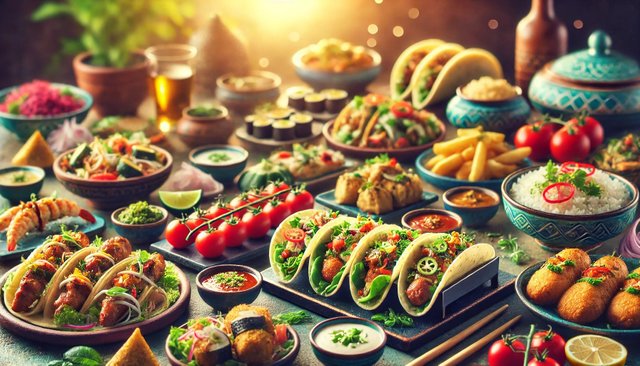Cultural Aspects of Food

Food is a fundamental part of every culture, reflecting history, geography, and societal values. It’s not just what people eat, but how and why they eat it that defines a culture. Let's explore the cultural aspects of food and how it shapes identities, reflects values, and evolves through globalization.
What Role Does Food Play in Cultural Identity?
Defining Culinary Identity Across Cultures
Culinary identity is deeply rooted in the foods and traditions of a culture. For example, Italian cuisine, with its emphasis on pasta and olive oil, reflects the Mediterranean climate and history of agriculture. Similarly, Japanese sushi highlights the country's proximity to the sea and its focus on fresh, simple ingredients.
How Traditional Food Shapes National Identity
Traditional foods are often synonymous with national identity. For instance, France's croissants and cheeses are symbols of French culinary heritage, while Mexico's tacos represent the country’s indigenous and colonial history. These dishes are not only popular within their home countries but have also become ambassadors of national identity abroad.
The Connection Between Food and Ethnic Identity
Ethnic identity is closely tied to food. For many immigrant communities, maintaining traditional food practices is a way to preserve their cultural heritage in a new environment. Chinese-American communities, for instance, have adapted their cuisine while still keeping the essence of their culinary roots.
How Do Food Practices Reflect Cultural Values?
The Significance of Food Rituals in Different Cultures
Food rituals play a crucial role in cultural practices. In India, the preparation and consumption of food during festivals like Diwali are steeped in religious significance. Similarly, in Japan, the tea ceremony is a ritual that embodies harmony, respect, purity, and tranquility.
Food Taboos and Their Cultural Meaning
Food taboos are prohibitions or restrictions on certain foods that are often rooted in religious or cultural beliefs. For example, in Hinduism, beef is taboo due to the sacred status of cows, while in Islam, pork is prohibited for its perceived impurity.
How Are Food and Religion Interconnected?
Food and religion are deeply interconnected, with many religions prescribing specific dietary laws. For example, Kosher laws in Judaism dictate what can be eaten and how food should be prepared, while Halal dietary laws in Islam serve a similar purpose. These practices are a way to maintain religious identity and community cohesion.
What Is the Impact of Globalization on Traditional Cuisines?
How Has Globalization Transformed Local Food Practices?
Globalization has had a profound impact on local food practices. It has led to the widespread availability of ingredients from around the world, transforming traditional dishes. For example, sushi, once exclusive to Japan, is now a global phenomenon, often adapted to suit local tastes.
The Spread of Fusion Cuisine and Its Cultural Implications
Fusion cuisine is a direct result of globalization, blending elements from different culinary traditions. While this creates innovative dishes, it can also dilute traditional practices. For instance, Tex-Mex cuisine combines elements of Mexican and American food but differs significantly from authentic Mexican cuisine.
Preserving Traditional Foods in a Globalized World
Preserving traditional foods in a globalized world is challenging, but it's essential for maintaining cultural heritage. Initiatives like Slow Food promote the preservation of traditional cooking methods and local ingredients, ensuring that cultural identity is not lost.
How Is Food Central to Social Gatherings and Celebrations?
The Role of Food in Family and Community Gatherings
Food plays a central role in family and community gatherings. In many cultures, meals are a time for bonding and celebration. For example, in Italy, Sunday family meals are a cherished tradition, while in China, the Lunar New Year is marked by family feasts.
Celebrating Festivals and Holidays Through Food
Festivals and holidays are often centered around specific foods. During Thanksgiving in the United States, turkey is the main dish, symbolizing gratitude and abundance. Similarly, during Ramadan, Muslims break their fast with dates, a tradition rooted in the practices of the Prophet Muhammad.
Food as a Symbol in Cultural Ceremonies and Rituals
Food is often used as a symbol in cultural ceremonies and rituals. In many African cultures, food offerings are made to ancestors during rituals, symbolizing respect and remembrance. In Korea, Tteok, a rice cake, is traditionally shared during celebrations like Seollal (Lunar New Year), symbolizing prosperity and well-being.
What Are the Challenges of Maintaining Food Heritage?
The Loss of Traditional Recipes and Culinary Techniques
One of the major challenges in maintaining food heritage is the loss of traditional recipes and culinary techniques. As modern convenience foods become more prevalent, the knowledge of traditional cooking methods is at risk of being lost.
The Role of Education in Preserving Culinary Heritage
Education plays a crucial role in preserving culinary heritage. Teaching younger generations traditional cooking methods and the significance of certain foods helps keep cultural practices alive. Culinary schools and cultural programs are essential in this effort.
Sustainable Practices in Maintaining Cultural Food Traditions
Sustainability is key to maintaining cultural food traditions. Using local and seasonal ingredients not only preserves the environment but also maintains the integrity of traditional dishes. Farm-to-table movements are an example of how sustainability can be integrated into preserving food heritage.